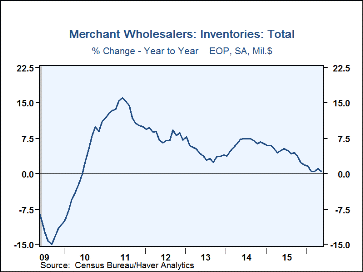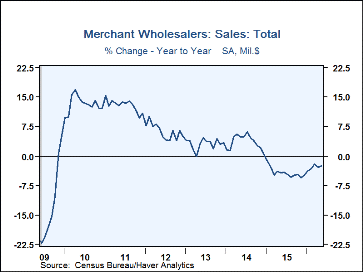 Global| Jul 12 2016
Global| Jul 12 2016U.S. Wholesale Inventories Tick Higher; Sales Firm
by:Tom Moeller
|in:Economy in Brief
Summary
Inventories at the wholesale level notched 0.1% higher during May following a 0.7% April increase, revised from 0.6%. Nondurable goods sector inventories rose 0.2% (4.9% y/y) after a 1.6% jump. Farm-product inventories were strong [...]
Inventories at the wholesale level notched 0.1% higher during May following a 0.7% April increase, revised from 0.6%. Nondurable goods sector inventories rose 0.2% (4.9% y/y) after a 1.6% jump. Farm-product inventories were strong again and jumped 5.9% (25.9% y/y), while apparel inventories increased 1.2% (7.9% y/y). Petroleum & products inventories rose 3.2% (0.7% y/y). In the durable goods area, inventories rose 0.1% (-2.3% y/y). Electrical equipment inventories gained 1.1% (-3.2% y/y). Machinery inventories increased 0.5% (-1.5% y/y), but motor vehicle inventories fell 1.9% (+0.9% y/y).
Wholesale sector sales increased 0.5% (0.3% y/y) after a 0.8% April gain. Nondurable goods buying increased 0.5% (-1.6% y/y) as petroleum & petroleum product sales jumped another 5.6% (-15.7% y/y) with higher prices. Apparel sales surged 2.6% (2.4% y/y), but chemical sales fell 0.5% (-1.7% y/y). Durable goods purchases increased 0.6% (2.6% y/y), but motor vehicle sales fell 1.2% (-1.6% y/y). Furniture & home furnishings sales improved 1.3% (13.5% y/y). Machinery purchases eased 0.1% (+4.2%% y/y), but electrical equipment sales jumped 2.4% (3.2% y/y).
The inventory-to-sales ratio in the wholesale sector eased to 1.35, down from the expansion high of 1.37 reached in January. The nondurable goods ratio held steady at 1.05 as the petroleum ratio eased to 0.47. The ratio in the apparel sector backed off the record to 2.30, and the chemicals ratio was steady at an elevated 1.27. In the durable goods sector, the I/S ratio declined to 1.67, down from the August high of 1.72. The 3.02 machinery ratio was steady, but the ratio in electrical goods fell to 1.01. The ratio of 1.78 in the auto sector was down from expansion high of 1.81 reached in January. That was up sharply from 1.53 averaged in 2012.
The wholesale trade figures are available in Haver's USECON database.
| Wholesale Sector - NAICS Classification (%) | May | Apr | Mar | Y/Y | 2015 | 2014 | 2013 |
|---|---|---|---|---|---|---|---|
| Inventories | 0.1 | 0.7 | 0.2 | 0.4 | 1.8 | 6.4 | 3.8 |
| Sales | 0.5 | 0.8 | 0.6 | 0.3 | -4.3 | 3.6 | 3.0 |
| I/S Ratio | 1.35 | 1.36 | 1.36 | 1.31 (May '15) | 1.30 | 1.20 | 1.18 |
Tom Moeller
AuthorMore in Author Profile »Prior to joining Haver Analytics in 2000, Mr. Moeller worked as the Economist at Chancellor Capital Management from 1985 to 1999. There, he developed comprehensive economic forecasts and interpreted economic data for equity and fixed income portfolio managers. Also at Chancellor, Mr. Moeller worked as an equity analyst and was responsible for researching and rating companies in the economically sensitive automobile and housing industries for investment in Chancellor’s equity portfolio. Prior to joining Chancellor, Mr. Moeller was an Economist at Citibank from 1979 to 1984. He also analyzed pricing behavior in the metals industry for the Council on Wage and Price Stability in Washington, D.C. In 1999, Mr. Moeller received the award for most accurate forecast from the Forecasters' Club of New York. From 1990 to 1992 he was President of the New York Association for Business Economists. Mr. Moeller earned an M.B.A. in Finance from Fordham University, where he graduated in 1987. He holds a Bachelor of Arts in Economics from George Washington University.










